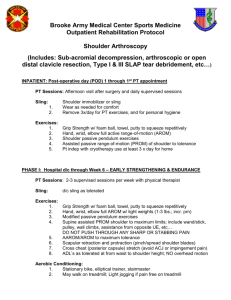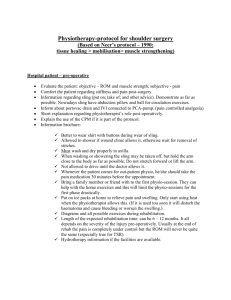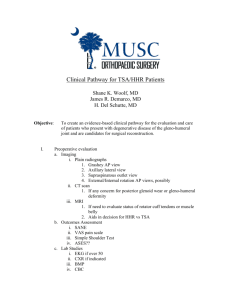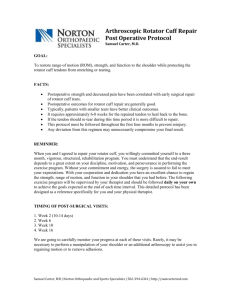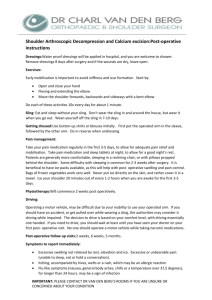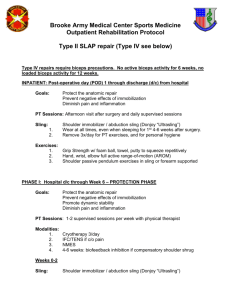orthopedic surgery and physical therapy
advertisement
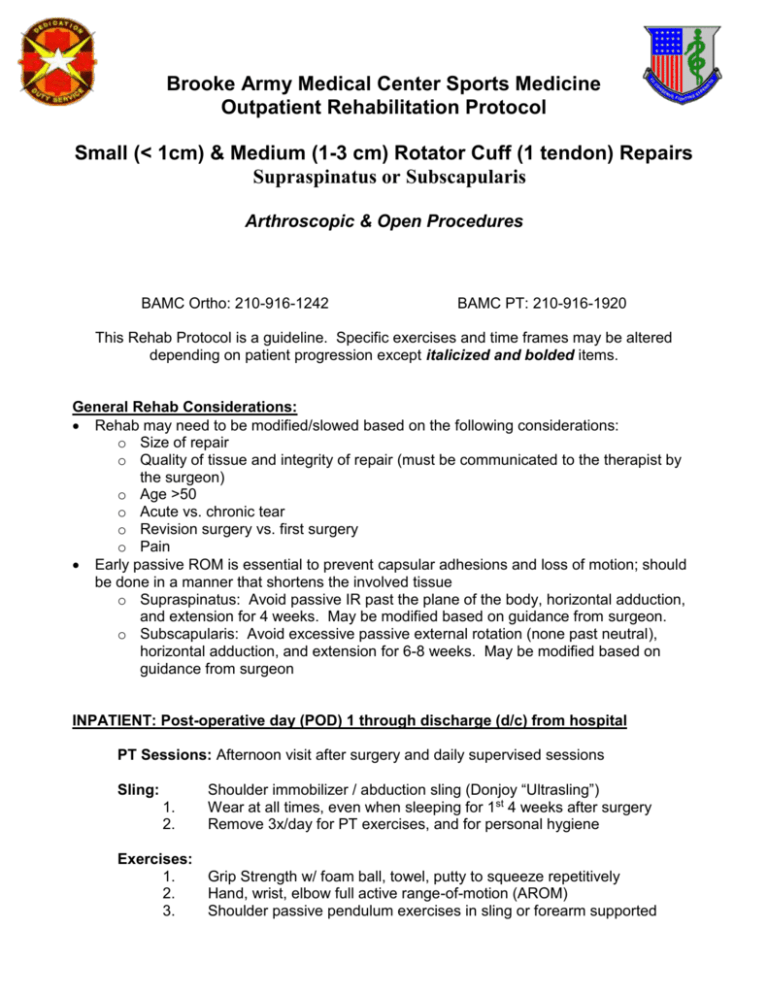
Brooke Army Medical Center Sports Medicine Outpatient Rehabilitation Protocol Small (< 1cm) & Medium (1-3 cm) Rotator Cuff (1 tendon) Repairs Supraspinatus or Subscapularis Arthroscopic & Open Procedures BAMC Ortho: 210-916-1242 BAMC PT: 210-916-1920 This Rehab Protocol is a guideline. Specific exercises and time frames may be altered depending on patient progression except italicized and bolded items. General Rehab Considerations: Rehab may need to be modified/slowed based on the following considerations: o Size of repair o Quality of tissue and integrity of repair (must be communicated to the therapist by the surgeon) o Age >50 o Acute vs. chronic tear o Revision surgery vs. first surgery o Pain Early passive ROM is essential to prevent capsular adhesions and loss of motion; should be done in a manner that shortens the involved tissue o Supraspinatus: Avoid passive IR past the plane of the body, horizontal adduction, and extension for 4 weeks. May be modified based on guidance from surgeon. o Subscapularis: Avoid excessive passive external rotation (none past neutral), horizontal adduction, and extension for 6-8 weeks. May be modified based on guidance from surgeon INPATIENT: Post-operative day (POD) 1 through discharge (d/c) from hospital PT Sessions: Afternoon visit after surgery and daily supervised sessions Sling: 1. 2. Exercises: 1. 2. 3. Shoulder immobilizer / abduction sling (Donjoy “Ultrasling”) Wear at all times, even when sleeping for 1st 4 weeks after surgery Remove 3x/day for PT exercises, and for personal hygiene Grip Strength w/ foam ball, towel, putty to squeeze repetitively Hand, wrist, elbow full active range-of-motion (AROM) Shoulder passive pendulum exercises in sling or forearm supported 4. 5. Assisted passive range-of-motion (PROM) of shoulder to maximum of 45 flexion, 30 external rotation (neutral for subscapularis), 45 abduction; NO extension Pt indep with cryotherapy use at least 3 x day at home PHASE I: Hospital d/c through Week 4 – PROTECTION PHASE PT Sessions: 2-3 supervised sessions per week with physical therapist Sling: 1. 2. Exercises: 1. 2. 3. 4. 5. 6. Shoulder immobilizer / abduction/IR sling (Donjoy “Ultrasling”) Wear at all times, even when sleeping for 1st 4 weeks after surgery Remove 3x/day for home PT exercises, and for personal hygiene Grip Strength w/ foam ball, towel, putty Hand, wrist, elbow full AROM w/ light weights (1-3 lbs.; incr. prn) Modified passive pendulum exercises in sling or forearm supported Supine assisted PROM shoulder to tolerance (with a goal of 90 flexion, 45 external rotation(neutral for subscapularis), 90 abduction by the 4th week); NO extension Scapular retraction; gently pinch shoulder blades together for 5 sec Postural correction exercises Aerobic Conditioning: may ride stationary bike while wearing immobilizer Continue Cryotherapy PHASE II: Week 4 - 8 – EARLY STRENGTHENING & ENDURANCE PT Sessions: 2-3 supervised sessions per week with physical therapist Sling: Wean shoulder immobilizer / sling Exercises: 1. 2. 3. 4. 5. 6. 7. 8. Continue grip strength exercises Continue hand, wrist, elbow full AROM w/ weights Passive pendulums w/ elbow extended and forearm unsupported Supine and active assisted ROM to maximum tolerance; include wand/stick, pulley, wall climbs, assistance from opposite UE, etc… DO NOT PUSH THROUGH ANY SHARP OR STABBING PAIN Active assisted range-of-motion (AAROM) for ER and gentle IR Scapular retraction and protraction (pinch/spread shoulder blades) Cross chest (posterior capsule) stretch Gentle ADL’s at or below waist level; NO sudden movements Subscapularis repairs: Neutral ER for 6-8 weeks, no active IR for 8 weeks Small repairs: May initiate gentle AROM and RC theraband exercises if ROM goals are being met and pain is well-controlled at 4 weeks. Medium repairs: May initiate gentle AROM and RC theraband exercises if ROM goals are being met and pain is well-controlled at 6 weeks. Aerobic Conditioning: Stationary bike or treadmill while wearing sling Criteria for Progression to PHASE III: 1. 90% Full PROM 2. Pain-free ADL’s up to chest height PHASE III: Week 8 - 12 – ADVANCED STRENGTHENING & ENDURANCE PT Sessions: 2-3 supervised sessions per week with physical therapist Sling: none Exercises: 1. 2. 3. 4. Continue previous grip and hand/wrist/elbow AROM exercises Progress from AAROM to AROM; emphasize terminal stretching Gentle shoulder AROM and rotator cuff strengthening; use theraband Moderate ADL’s from waist to shoulder; NO overhead activity Subscap PROM to 30 degrees Aerobic Conditioning: 1. Stationary bike, elliptical trainer, stairmaster 2. May walk on treadmill; NO running 3. Upper body cycle up to 5 min forward and 5 min backward Criteria for Progression to PHASE IV: 3. 90% shoulder FAROM (except subscap repair) 4. Pain-free ADL’s up to shoulder height 5. Able to perform 5 min of upper body cycle w/o pain PHASE IV: Week 12 - 16 – BASIC FUNCTIONAL PHASE PT Sessions: 1-2 supervised sessions per week with physical therapist Exercises: 1. 2. 3. 4. 5. Continue all previous exercises Address all residual strength and ROM impairments a. Capsular stretches as needed b. Progressive resistance exercises for shoulder girdle complex Full ADL’s with no lifting > 10 lbs. Basic aquatic (pool) therapy if available Slowly advance motion into ER with subscap Aerobic Conditioning: 1. 2. May begin jogging (if painfree) Upper body cycle up to 10-15 min forward and 10-15 min backward Criteria for Progression to PHASE V: 1. Full or nearly full shoulder AROM 2. Near full strength per manual muscle testing 3. Pain-free basic functional training exercises PHASE V: Week 16 - 24 (6 mo) – ADVANCED FUNCTIONAL PHASE PT Sessions: 1-2 supervised sessions per week with physical therapist Exercises: 1. 2. 3. Full AROM exercises to fatigue Gradually increase weight training to maximum; must be pain free Advanced pool therapy if available Aerobic Conditioning: 1. Progress from jogging to running prn; should be pain-free 2. Sport or activity-specific drills prn; i.e. throwing, catching, swinging PHASE VI: 6 Months + – RETURN TO FULL DUTY PHASE When rehabilitation goals are met: 1. Full shoulder AROM (accept 5-10 loss of ER) 2. Full strength per manual and isokinetic testing 3. Able to pass APFT, including push-ups ______________________ JAMES R. FICKE, MD COL, MC Chief, Orthopedics ___________________________ KATHLEEN S. ZURAWEL, PT, OCS COL, SP Chief, Physical Therapy APPROVE / DISAPPROVE APPROVE / DISAPPROVE Updated 30 October 2006
